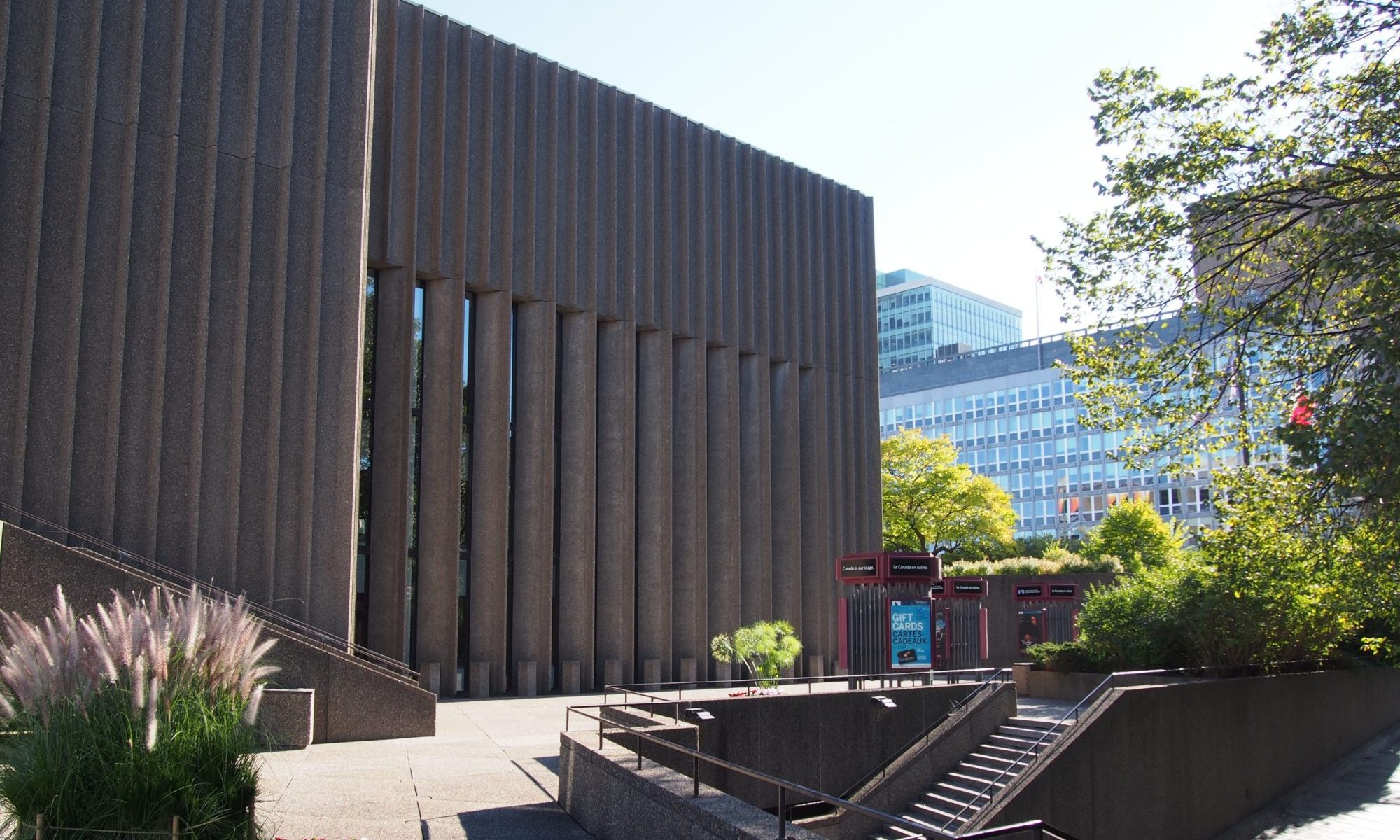
Statement of Significance
The National Arts Centre in Ottawa is a National Historic Site of Canada recognizing not only the building but extending to the events that occur within the building. At the time of the building’s construction it represented one of the few arts facilities where multiple theatre spaces were constructed under a single roof or in this case under a series of interconnected terraces. It also reflected the confluence of three key desires that would eventually lead it to being:
- Desire to establish and celebrate a uniquely Canadian culture as highlighted by the Massey Commission’s report tabled in 1951 titled: Royal Commission on National Development in the Arts, Letters and Sciences 1949-1951.
- Interest in creating a physical legacy to commemorate Canada’s Centennial. The National Arts Centre would be the largest such project undertaken under an auspices of Canada’s Centennial.
- Construct a purpose-built arts centre for Canada’s capital. From the 1930’s until the completion of the NAC in 1969, local and travelling performances shared space with the movie’s at Famous Players Capitol Theatre, a less than ideal situation due to the lack of backstage facilities.
National Historic Site of Canada recognition is largely honorific as it carries no legal standing that actually protects a building from minor or major alterations that may or may not obscure or eliminate its character-defining elements. In the case of the National Arts Centre, the list of character-defining elements is extensive covering the functionality, spatial flow, architecture and finishes of the building on both the exterior and interior.
The following is the Statement of Significance for the National Arts Centre which is also available at historicplaces.ca
The National Arts Centre is also an integral part of the Confederation Square National Historic Site of Canada that houses the National War memorial.
Description of Historic Place
The National Arts Centre is a complex structure of irregular plan whose design is based on the triangle and hexagon, from the overall composition down to decorative details. The building houses several performance spaces, rehearsal halls, dressing rooms, a workshop and prop room, offices, restaurants, reception spaces and subterranean parking garage. Designed in the Brutalist style, the National Arts Centre is constructed of poured reinforced concrete and covered with precast panels of exposed Laurentian-granite aggregate concrete with a variety of textures. The visually dominant components of its irregular design are the three main performing spaces that rise above a series of terraces.
Heritage Value
The National Arts Centre was designated a national historic site of Canada because:
- it is an outstanding example of a performing arts centre in Canada for its overall design, its highly successful integration into its urban setting, its succession of interior spaces to create dramatic effect, its unique combination of performing spaces and the progressive designs of each one, and its integration of contemporary works of art as part of its design;
- it is an outstanding example of a building illustrating the positive consequences of Canadian federal policy on the performing arts during the second half of the 20th century, considered, in the words of Prime Minister Lester B. Pearson, as a “national institution”;
- it is an example of state-of-the-art performing spaces and technology at the time of construction, in particular for the aesthetic and technical design of Southam Hall, which is an exceptional example of a medium-sized multi-purpose auditorium representing an inspired collaboration between architect and acoustician.
The National Arts Centre was both a major cultural as well as a major architectural achievement for the country. The structure, built in 1965-69 to designs by the architectural firm of Affleck, Desbarats, Dimakopoulos, Lebensold and Sise, reflects the rise of state support to the arts in the second half of the 20th century. It was built as part of the celebrations of for the one-hundredth anniversary of Confederation, and it was intended to herald the cultural achievements of the nation in the fields of the performing arts. The National Arts Centre is also a component of the Confederation Square National Historic Site of Canada.
Sources: Historic Sites and Monuments Board of Canada, Submission Report, Minutes, 2005.
Character-Defining Elements
Key elements contributing to the heritage value of this site include:
- its current siting, in relation to the Rideau Canal, Elgin Street, Laurier Avenue, Sapper’s Bridge, and the Confederation Square National Historic Site of Canada;
- its exterior volumes, composed of a pyramidal building-up of hexagonal shapes, masses which contain the interior spaces, and open terraces and planters;
- the open terraces, and their role as gathering areas and as linking spaces in the larger urban context;
- the richly treated concrete surfaces of the exterior;
- the interior disposition of spaces, including the performance spaces, administration and prop spaces, reception spaces, halls, and public parking;
- the finishing details, such as the types of wall and floor coverings, specially designed light fixtures, curtains, seating, sculptures, paintings, tapestries and other accoutrements especially designed for this building.
